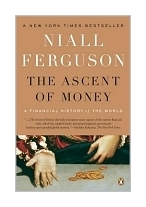Money, says the song, makes the world go round. It can also threaten to stop
it. Thus, a book that explains the origin and growth of money, banks, stock
markets, and the exotic growth of the financial instruments and institutions that often
bewilder even those who live by them, is a valuable thing. Despite the fact that Niall
Ferguson finished writing The Ascent of Money in the late spring of 2008, while the
international financial crisis was still gathering momentum, this is a highly relevant
book. Not the least of its merits is that Ferguson shows how alert he was to the
possibilities for disaster inherent in the loose credit and securitization of bad debt
from which so much money was made before the crisis unfolded. His was an alertness made
possible by a grasp of history; Ferguson thereby vindicates the utility as well as the
beauty of his craft.
The story, a fascinating one, covers 4,000 years. Money is the concrete
expression of the relationship between lenders and borrowers -- it is the embodiment of
debt made tradeable -- and it gave rise to banks, which in turn gave a vast boost to the
development of credit. From medieval times to the present, the Darwinian evolution (as
Ferguson convincingly characterizes it) of money and markets proceeded at an increasing
pace and sophistication. Bonds came first, from the 13th century onward securitizing
revenue from interest. The 17th-century Dutch invented equity in corporations in the form
of shares carrying limited liability. In the 17th and 18th centuries, economies of scale
and an understanding of mathematical probability yielded protection against risk in the
form of insurance and pension funds. The 19th century saw the rise of the first
derivatives in the form of options and futures. In the20th century individuals were
encouraged to redirect their portfolios toward real estate, accepting the need for greatly
increased leverage to do so.
Ferguson points out that the economies where all these things happened -- that is, the
property-owning democracies with banks, bonds and stock markets, and insurance cover --
have consistently performed better than other economies. Or rather: at least until now.
But in the last couple of decades there has been a "Cambrian explosion" of new
types of financial services and assets and a seemingly boundless appetite for asset-backed
securities, not least mortgages. Perhaps the long roots of this lay in the collapse of the
Bretton Woods control of capital movements in the early 1970s, following which the
globalization of financial dealings has mushroomed, aided by substantial deregulation in
the 1990s and since. The result has been a huge bubble, the pricking of which we are now
witnessing.
In fact there have been scores of periodic financial crises in recent history, as Ferguson
shows, illustrating the inherent volatility of the financial markets, in which greed and
-- when greed has over-gorged itself -- fear are the principal sentiments. One thing
Ferguson's book emphatically shows is that the new concept of "behavioral
economics" provides a far better description of what happens in the markets than any
of the theories previously mooted, including the fancy mathematical models that were
supposed to make investment foolproof. These latter depended upon the markets being
rational and predictable; history shows that matters are otherwise.
There is a good deal of riveting information here about the buildup to the current crisis,
in discussions of the Enron scandal, the way speculators such as George Soros make their
money, the unparalleled mushrooming of securitized debt obligations that -- because so
many of them are of such poor quality -- has rocked previously secure banks to their
foundations around the world. Ferguson describes what went wrong with Long Term Capital
Management, the once-so-successful investment company that failed despite the intricacy of
its model and spread of its assets. Because, Ferguson points out, its managers knew too
little history, they learned the hard way John Maynard Keynes's insight that in times of
crisis, "markets can remain irrational longer than you can remain solvent."
Not only is there much that is instructive and illuminating in Ferguson's account, there
is much that is absorbing. Until you begin reading you might not imagine how engrossing a
book about the history of money and finance can be. The story of money's origins, of the
Italian Renaissance cities, of the founding and operation of the first limited liability
company in the Netherlands, of the Rothschild banking dynasty's rise in the 19th century,
of what caused the Great Depression, of the turn to house-owning debt, of today's massive
and perhaps unhealthy symbiosis between borrowing America and lending, cheaply
manufacturing China to make "Chimerica" with most of the world's money and
population in it, make an altogether gripping tale. --A. C. Grayling
Table of Contents
Introduction 1
1 Dreams of Avarice 17
2 Of Human Bondage 65
3 Blowing Bubbles 119
4 The Return of Risk 176
5 Safe as Houses 230
6 From Empire to Chimerica 283
Afterword: The Descent of Money 341
Notes 363
List of Illustrations 399
Index 403
448 pages, Paperback
Księgarnia nie działa. Nie odpowiadamy na pytania i nie realizujemy zamówien. Do odwolania !.


